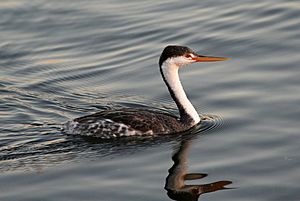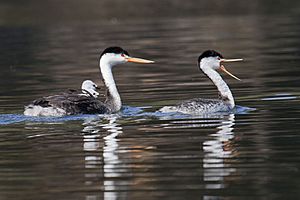Clark's grebe facts for kids
Quick facts for kids Clark's grebe |
|
|---|---|
 |
|
| Nonbreeding plumage | |
| Conservation status | |
| Scientific classification | |
| Genus: |
Aechmophorus
|
| Species: |
clarkii
|
 |
|
The Clark's grebe (Aechmophorus clarkii) is a cool waterbird found in North America. It belongs to the grebe family. For a long time, people thought it was just a lighter-colored version of the western grebe. This is because they look very similar! They are about the same size, live in the same places, and act alike. Sometimes, you can even find birds that look like a mix of both species.
These grebes build their nests on big lakes in western North America. When winter comes, they fly to the Pacific Ocean coast. Some populations stay in places like California, Nevada, and Arizona all year. You can also find them in central Mexico.
Clark's grebes are great divers. They hunt for insects, worms, crabs and shrimp, and even small salamanders underwater. They also do a fancy dance to find a mate, just like the western grebe.
Contents
What's in a Name?
The name "Clark's" comes from John Henry Clark. He was an American surveyor in the 1800s who also loved nature and collected specimens. That's why the scientific name is clarkii.
The genus name Aechmophorus is from Ancient Greece. It means 'spear point bearer'. This name describes the bird's long, sharp beak, which looks a bit like a spear.
In Mexico, people call this bird achichilique pico naranja. This means "orange-billed achichilique." The western grebe is called achichilique pico amarillo (yellow-billed achichilique).
How to Spot a Clark's Grebe
Clark's grebes look a lot like western grebes. They often live in the same groups. But there are a few ways to tell them apart:
- Color: Clark's grebes usually have lighter feathers on their backs.
- Face: More of their face is white. The white feathers go above their eyes, not just below them.
- Beak: Their beak is a bright yellow. Western grebes usually have a greenish-yellow beak.
- Beak Shape: Some experts say the Clark's grebe's beak is slightly upturned, while the western grebe's is straight.
These birds have long, thin necks. They can be about 56 to 74 centimeters (22 to 29 inches) long. Their wings can spread about 61 centimeters (24 inches) wide. They weigh between 718 and 1258 grams (25.3 to 44.4 ounces).
It's hard to tell males and females apart. Males might have a small crest of feathers on their heads. Young Clark's grebes look similar to young western grebes, but they are paler.
Clark's Grebe Family Tree
Clark's grebe (Aechmophorus clarkii) is a waterbird in the family Podicipedidae. This family is part of the order Podicipediformes. Believe it or not, grebes are related to flamingos!
A Bit of History
Clark's grebes and western grebes are super similar. They act the same, have the same fancy courtship dances, live in the same areas, and even migrate together. They also look almost identical, with Clark's grebes just being a bit paler. Because of this, for a long time, scientists thought they were the same species, just different color versions.
In 1858, a scientist named George Newbold Lawrence first described the lighter-colored bird as its own species, Podiceps clarkii. But later, most scientists decided they were the same.
However, in the 1960s and 70s, new studies showed some small differences. For example, the western grebe has a greenish-yellow beak, while Clark's grebe has a bright yellow one. Also, the black feathers on the top of the Clark's grebe's head don't go as far down its face as on the western grebe.
By the 1980s, scientists noticed that even though these birds lived together, they didn't often breed with each other. This suggested they were indeed separate species. So, now Clark's grebe is recognized as its own unique species.
Where They Live
Home Sweet Home
Clark's grebes are waterbirds, so they need bodies of water to live. They look for lakes or wetlands that have enough food and places to hide. They also like to be near trees for nesting.
Their Travels
Clark's grebes live in western North America. You can find them as far south as Mexico and as far north as British Columbia and Saskatchewan in Canada. They don't like the cold, so they only stay in the central USA and Canada during the warm summer breeding season.
During breeding season, they gather in large groups on big bodies of water across the western parts of the US and Canada, from British Columbia down to Texas. In winter, they usually move to the Pacific coast. In Mexico, they live along the Pacific coast and in the mountains of central Mexico.
Grebe Habits
Their Calls
The calls of the Clark's grebe sound a lot like the western grebe. But when they are trying to find a mate, they make a special "advertising call." It sounds like a single, long kreeeed. The western grebe's call is a two-note kreed-kreet. Both male and female grebes make very similar calls.
What They Eat
In the past, people thought Clark's grebes only ate fish. But by 1962, scientists learned that these birds are not picky eaters! They are "opportunists," meaning they will eat many different things. While they love small fish, they also dive for salamanders, crabs and shrimp, worms, and insects. They'll eat anything that fits in their beak!
How They Raise Families
Clark's grebes seem to be "semi-monogamous." This means they usually stay with one mate, but maybe only for one breeding season. There are often more single males than females. Males will stay with their mate until their chicks are a few weeks old.
Before mating, they perform two amazing courtship dances: the "rushing ceremony" and the "weed ceremony." In the rushing ceremony, they do a series of synchronized moves with their partner. In the weed ceremony, the male presents the female with a bundle of weeds and they perform different dances. Since there are fewer females, the female usually makes the final decision about who to mate with. These dances happen in spring when they arrive at their breeding grounds.
It's rare, but Clark's grebes and western grebes can sometimes breed together. When they do, their offspring can look like a mix of both species and can even have their own babies.
Gallery
See also
 In Spanish: Achichilique de Clark para niños
In Spanish: Achichilique de Clark para niños






